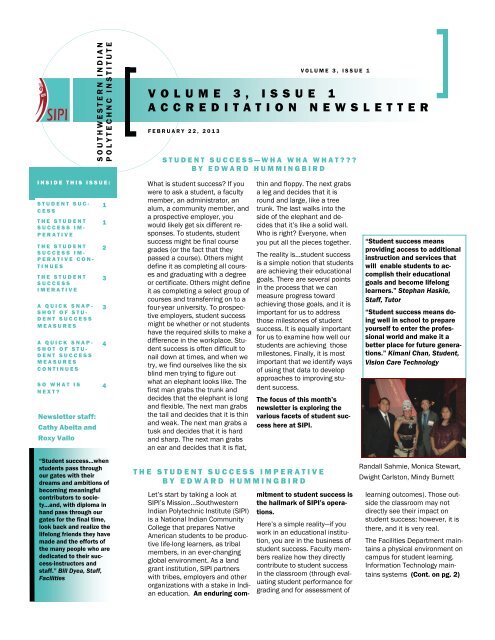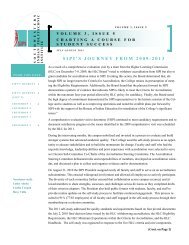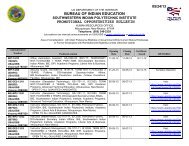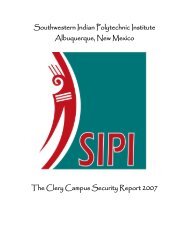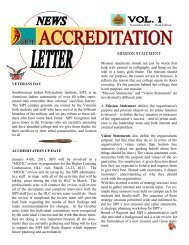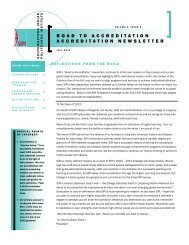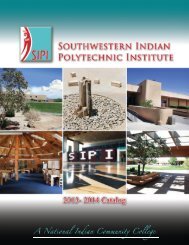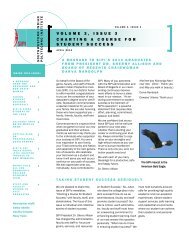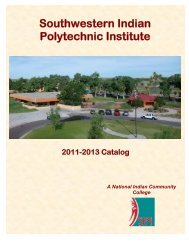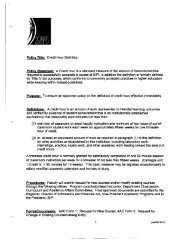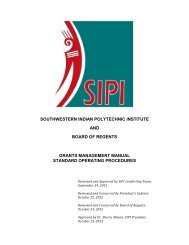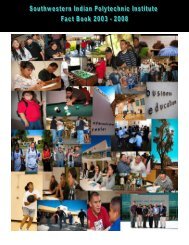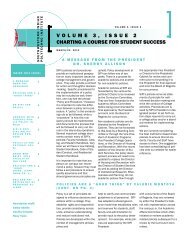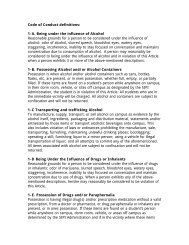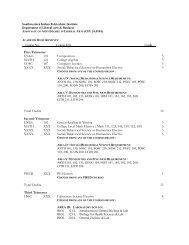volume 3, issue 1 accreditation newsletter - Southwestern Indian ...
volume 3, issue 1 accreditation newsletter - Southwestern Indian ...
volume 3, issue 1 accreditation newsletter - Southwestern Indian ...
You also want an ePaper? Increase the reach of your titles
YUMPU automatically turns print PDFs into web optimized ePapers that Google loves.
SOUTHWESTERN INDIAN<br />
POLYTECHNC INSTITUTE<br />
FEBRUARY 22, 2013<br />
VOLUME 3, ISSUE 1<br />
VOLUME 3, ISSUE 1<br />
ACCREDITATION NEWSLETTER<br />
STUDENT SUCCESS—WHA WHA WHAT???<br />
BY EDWARD HUMMINGBIRD<br />
INSIDE THIS ISSUE:<br />
STUDENT SUC-<br />
CESS<br />
THE STUDENT<br />
SUCCESS IM-<br />
PERATIVE<br />
THE STUDENT<br />
SUCCESS IM-<br />
PERATIVE CON-<br />
TINUES<br />
THE STUDENT<br />
SUCCESS<br />
IMERATIVE<br />
A QUICK SNAP-<br />
SHOT OF STU-<br />
DENT SUCCESS<br />
MEASURES<br />
A QUICK SNAP-<br />
SHOT OF STU-<br />
DENT SUCCESS<br />
MEASURES<br />
CONTINUES<br />
SO WHAT IS<br />
NEXT?<br />
Newsletter staff:<br />
Cathy Abeita and<br />
Roxy Vallo<br />
1<br />
1<br />
2<br />
3<br />
3<br />
4<br />
4<br />
“Student success...when<br />
students pass through<br />
our gates with their<br />
dreams and ambitions of<br />
becoming meaningful<br />
contributors to society...and,<br />
with diploma in<br />
hand pass through our<br />
gates for the final time,<br />
look back and realize the<br />
lifelong friends they have<br />
made and the efforts of<br />
the many people who are<br />
dedicated to their success-instructors<br />
and<br />
staff.” Bill Dyea, Staff,<br />
Facilities<br />
What is student success? If you<br />
were to ask a student, a faculty<br />
member, an administrator, an<br />
alum, a community member, and<br />
a prospective employer, you<br />
would likely get six different responses.<br />
To students, student<br />
success might be final course<br />
grades (or the fact that they<br />
passed a course). Others might<br />
define it as completing all courses<br />
and graduating with a degree<br />
or certificate. Others might define<br />
it as completing a select group of<br />
courses and transferring on to a<br />
four-year university. To prospective<br />
employers, student success<br />
might be whether or not students<br />
have the required skills to make a<br />
difference in the workplace. Student<br />
success is often difficult to<br />
nail down at times, and when we<br />
try, we find ourselves like the six<br />
blind men trying to figure out<br />
what an elephant looks like. The<br />
first man grabs the trunk and<br />
decides that the elephant is long<br />
and flexible. The next man grabs<br />
the tail and decides that it is thin<br />
and weak. The next man grabs a<br />
tusk and decides that it is hard<br />
and sharp. The next man grabs<br />
an ear and decides that it is flat,<br />
thin and floppy. The next grabs<br />
a leg and decides that it is<br />
round and large, like a tree<br />
trunk. The last walks into the<br />
side of the elephant and decides<br />
that it’s like a solid wall.<br />
Who is right? Everyone, when<br />
you put all the pieces together.<br />
The reality is...student success<br />
is a simple notion that students<br />
are achieving their educational<br />
goals. There are several points<br />
in the process that we can<br />
measure progress toward<br />
achieving those goals, and it is<br />
important for us to address<br />
those milestones of student<br />
success. It is equally important<br />
for us to examine how well our<br />
students are achieving those<br />
milestones. Finally, it is most<br />
important that we identify ways<br />
of using that data to develop<br />
approaches to improving student<br />
success.<br />
The focus of this month’s<br />
<strong>newsletter</strong> is exploring the<br />
various facets of student success<br />
here at SIPI.<br />
THE STUDENT SUCCESS IMPERATIVE<br />
BY EDWARD HUMMINGBIRD<br />
Let’s start by taking a look at<br />
SIPI’s Mission...<strong>Southwestern</strong><br />
<strong>Indian</strong> Polytechnic Institute (SIPI)<br />
is a National <strong>Indian</strong> Community<br />
College that prepares Native<br />
American students to be productive<br />
life-long learners, as tribal<br />
members, in an ever-changing<br />
global environment. As a land<br />
grant institution, SIPI partners<br />
with tribes, employers and other<br />
organizations with a stake in <strong>Indian</strong><br />
education. An enduring commitment<br />
to student success is<br />
the hallmark of SIPI’s operations.<br />
Here’s a simple reality—if you<br />
work in an educational institution,<br />
you are in the business of<br />
student success. Faculty members<br />
realize how they directly<br />
contribute to student success<br />
in the classroom (through evaluating<br />
student performance for<br />
grading and for assessment of<br />
“Student success means<br />
providing access to additional<br />
instruction and services that<br />
will enable students to accomplish<br />
their educational<br />
goals and become lifelong<br />
learners.” Stephan Haskie,<br />
Staff, Tutor<br />
“Student success means doing<br />
well in school to prepare<br />
yourself to enter the professional<br />
world and make it a<br />
better place for future generations.”<br />
Kimani Chan, Student,<br />
Vision Care Technology<br />
Randall Sahmie, Monica Stewart,<br />
Dwight Carlston, Mindy Burnett<br />
learning outcomes). Those outside<br />
the classroom may not<br />
directly see their impact on<br />
student success; however, it is<br />
there, and it is very real.<br />
The Facilities Department maintains<br />
a physical environment on<br />
campus for student learning.<br />
Information Technology maintains<br />
systems (Cont. on pg. 2)
VOLUME 3, ISSUE 1<br />
Page 2<br />
THE STUDENT SUCCESS IMPERATIVE (CONT. FROM PG. 1)<br />
for managing courses and<br />
communications. Human<br />
Resources maintains processes<br />
to ensure that qualified<br />
faculty and support staff<br />
are here to help students<br />
learn. Every department in<br />
the institution ultimately contributes<br />
directly to student<br />
success, or helps create an<br />
environment that enables<br />
students to succeed. In short,<br />
we’re all in this together.<br />
SIPI has in place actions to<br />
ensure continuous improvement<br />
of student learning and<br />
processes. A central <strong>issue</strong> in<br />
the continuous improvement<br />
process is that departments<br />
identify how “what they do”<br />
contributes to this environment<br />
for student success.<br />
SIPI also has in place processes<br />
for systematic review<br />
of program and department<br />
performance to ensure longterm<br />
sustainability. At the<br />
heart of this process is the<br />
expectation that departments<br />
clearly define how they are<br />
contributing to student success.<br />
SIPI also has a strategic<br />
planning process, that requires<br />
departments and committees<br />
to develop initiatives<br />
that support the institution’s<br />
mission and vision. There are<br />
two major requirements for<br />
developing strategic initiatives:<br />
1) they are truly strategic<br />
in nature (they have a<br />
lasting, or enduring impact<br />
on the institution), and 2)<br />
they can be clearly viewed<br />
through a prism of student<br />
success (in other words, we<br />
can see how they will ultimately<br />
enable students to<br />
succeed).<br />
In the most recent version of<br />
the Higher Learning Commission’s<br />
(HLC) criteria for <strong>accreditation</strong>,<br />
a new section<br />
has been added, which requires<br />
us to explore various<br />
measures of student success.<br />
The following is the new<br />
component:<br />
4C. The institution demonstrates<br />
a commitment to<br />
educational improvement<br />
through ongoing attention to<br />
retention, persistence, and<br />
completion rates in its degree<br />
and certificate programs.<br />
1.The institution has defined<br />
goals for student retention,<br />
persistence, and completion<br />
that are ambitious but attainable<br />
and appropriate to its<br />
mission, student populations,<br />
and educational offerings.<br />
2.The institution collects and<br />
analyzes information on student<br />
retention, persistence,<br />
and completion of its programs.<br />
3.The institution uses information<br />
on student retention,<br />
persistence, and completion<br />
of programs to make improvements<br />
as warranted by<br />
the data.<br />
4.The institution’s processes<br />
and methodologies for collecting<br />
and analyzing information<br />
on student retention,<br />
persistence, and completion<br />
of programs reflect good<br />
practice. (Institutions are not<br />
required to use IPEDS definitions<br />
in their determination of<br />
persistence or completion<br />
rates. Institutions are encouraged<br />
to choose measures<br />
that are suitable to their student<br />
populations, but institutions<br />
are accountable for the<br />
validity of their measures.)<br />
Why did the HLC add this new<br />
component? At a recent<br />
workshop on the HLC’s expectations,<br />
they indicated<br />
that the purpose of this new<br />
component was to ensure<br />
that schools were having<br />
broad discussions of student<br />
success. How has this impacted<br />
SIPI? This expectation<br />
was the starting point for the<br />
Retention Committee to evaluate<br />
measures (based on<br />
historical data), set measurable<br />
goals (based on SIPI’s<br />
positions in the National<br />
Community College Benchmark<br />
Project), and augment<br />
tracking data with data on<br />
student motivations for success<br />
to develop data-driven<br />
success initiatives. These<br />
initiatives are still a work in<br />
progress, but the wheels are<br />
moving. An example of how<br />
SIPI is approaching this requirement<br />
is in persistence.<br />
Given the low persistence<br />
rates of SIPI students, the<br />
Research Office surveyed<br />
non-returning students to<br />
find out what factors kept<br />
them from returning to college.<br />
Students provided a<br />
variety of reasons for not<br />
returning, but those reasons<br />
appeared in patterns. By<br />
analyzing the data, four segments<br />
of non-returners were<br />
identified:<br />
Accomplished (37%)<br />
Completed desired courses<br />
Transferred to 4-year institution<br />
Transferred to 2-year institution<br />
SIPI lost <strong>accreditation</strong><br />
Other<br />
Disenfranchised (28%)<br />
Couldn’t get needed courses<br />
Couldn’t get courses at needed<br />
times<br />
Didn’t like instructor or instructional<br />
methods<br />
Was doing poorly in classes<br />
Had unpleasant experience<br />
Blocked from enrolling<br />
(Cont. on pg. 3)<br />
Audrey Gachupin’s family and<br />
Glennoah Billie, SIPI’s New<br />
Mexico All State Academicians<br />
“Student success is a measure<br />
of the support that a<br />
student receives. Faculty,<br />
staff, and fellow students all<br />
contribute to the success of<br />
the individual.” Randall<br />
Sahmie, Student Business<br />
Administration and Accounting<br />
Student success to<br />
me means that all<br />
Native American<br />
students within the<br />
United States are<br />
given the opportunity<br />
to achieve academic<br />
success in a safe,<br />
clean, living and<br />
learning environment.<br />
SIPI offers<br />
affordability where<br />
students can<br />
successfully complete<br />
their education goals<br />
and be prepared to<br />
continue onto a four<br />
year university.” Irene<br />
Shaw, Staff,<br />
Residential Life<br />
“Student success—when<br />
a student initially enrolls<br />
here at SIPI, is in the<br />
Adult Basic Education<br />
program, progresses onto<br />
a certificate or degree<br />
program, and graduates.<br />
This student then goes on<br />
to attend a four year university<br />
or gain employment<br />
in his/her field of<br />
study. This student has<br />
succeeded in accomplishing<br />
the goals he/she<br />
set!” Barbara Chino,<br />
Staff, Admissions
VOLUME 3, ISSUE 1<br />
Page 3<br />
THE STUDENT SUCCESS IMPERATIVE<br />
(CONT. FROM PG. 2)<br />
Personally Impacted (26%)<br />
Personal <strong>issue</strong>s<br />
Transportation <strong>issue</strong>s<br />
Needed child care<br />
Could not afford<br />
Lost room in dormitory<br />
Work Impacted (9%)<br />
Began full-time job<br />
Increased work hours/<br />
changed shift<br />
Schedule conflict<br />
Each segment had a unique<br />
profile. The following summarizes<br />
former students belonging<br />
to each segment:<br />
Accomplished—These were<br />
students who accomplished a<br />
meaningful part of their education<br />
goal at SIPI. Many of<br />
these are students who do<br />
not intend to graduate from<br />
SIPI, but want to complete a<br />
set of courses to either enhance<br />
their current skill set,<br />
or to prepare to transfer to<br />
another institution. This segment<br />
was deeply impacted by<br />
the loss of <strong>accreditation</strong> and<br />
repeatedly indicated concern<br />
that subsequent coursework<br />
taken at SIPI would not be<br />
accepted by other institutions.<br />
Disenfranchised – These<br />
were students who did not<br />
feel an adequate “fit” at SIPI.<br />
Many are students inconvenienced<br />
by the fact that they<br />
could not get what they wanted,<br />
when they wanted it at<br />
SIPI. It also includes students<br />
who struggled to succeed at<br />
SIPI, and had a less positive<br />
experience than other segments.<br />
Personally Impacted – These<br />
were students who were impacted<br />
by personal or financial<br />
<strong>issue</strong>s. This includes<br />
students who largely believed<br />
that they could succeed, had<br />
they not been subjected to<br />
A QUICK SNAPSHOT OF STUDENT SUCCESS<br />
MEASURES AT SIPI BY EDWARD HUMMINGBIRD<br />
extraordinary circumstances<br />
(beyond their or the institution’s<br />
control). These students<br />
are potential shortterm<br />
stop-outs, rather than<br />
long-term drop-outs. Before<br />
considering a return to college,<br />
they must rectify <strong>issue</strong>s<br />
that have become prohibitive<br />
barriers to success. These<br />
students were most likely to<br />
be impacted by a single tipping<br />
point.<br />
Work Impacted – This small<br />
segment includes working<br />
students who find it difficult<br />
to balance work and study.<br />
Because most SIPI students<br />
are full-time resident students,<br />
this group is the smallest.<br />
Like the personally impacted<br />
students, these students<br />
are potential shortterm<br />
stop-outs, rather than<br />
long-term drop-outs. These<br />
students were least likely to<br />
be impacted by a single tipping<br />
point, indicating that the<br />
work conflict was likely there<br />
from the start.<br />
By understanding the nature<br />
of non-returning students,<br />
the Research Office is developing<br />
a predictive model that<br />
will allow us to identify students<br />
most likely to face the<br />
pressures of any given segment,<br />
and develop resource<br />
portals that focus on those<br />
specific needs. Directing<br />
students to the appropriate<br />
resources before the student<br />
decides to drop out of college<br />
may help improve persistence.<br />
Our goal at SIPI is to<br />
base interventions like this<br />
on empirical data.<br />
“Student success is when a<br />
student does their best,<br />
stays true to themselves,<br />
works to achieve their<br />
goals, and learns along the<br />
way.” Erin Riley, Faculty,<br />
Natural Resources<br />
Course Retention Rates<br />
Retention is a measure of<br />
course completion (or students<br />
enrolled in a course at<br />
census date, who complete<br />
the course and receive a<br />
grade of A, B, C, D or F).<br />
Course retention is a building<br />
block for term-to-term persistence<br />
and degree completion.<br />
SIPI’s course completion<br />
rate for the Fall 2010<br />
trimester was 81.83%, which<br />
places SIPI in the 3 rd percentile<br />
of community colleges<br />
nationally (according to the<br />
2012 National Community<br />
College Benchmark Project).<br />
The SIPI Academic Affairs<br />
Committee has set a goal of<br />
increasing course retention<br />
by 2% annually, and is exploring<br />
actions that would substantially<br />
improve course<br />
retention. A course exit survey<br />
is being developed to<br />
allow students to provide<br />
feedback on <strong>issue</strong>s that led<br />
them to withdraw from courses,<br />
and provide guidance for<br />
corrective action.<br />
Course Completer Success<br />
Rates<br />
Of students who complete<br />
credit courses for the Fall<br />
2010 trimester, the success<br />
rate was 69.95%, which places<br />
SIPI in the lowest percentile<br />
of community colleges<br />
nationally (according to the<br />
2012 National Community<br />
College Benchmark Project).<br />
SIPI is currently working on<br />
strategic initiatives to improve<br />
student success, such<br />
as the hiring of additional<br />
tutors, hiring additional faculty,<br />
improving technological<br />
learning resources and library<br />
resources for students.<br />
Persistence Rates<br />
Of students enrolled at SIPI<br />
during the Fall 2010 trimester,<br />
59.34% returned to college for<br />
the Spring 2011 trimester. This<br />
persistence rate places SIPI in<br />
the 6 th percentile of community<br />
colleges nationally (according to<br />
the 2012 National Community<br />
College Benchmark Project). Of<br />
those students, 39.82% returned<br />
to SIPI for the Fall 2011 trimester.<br />
This persistence rate<br />
places SIPI in the 9 th percentile of<br />
community colleges nationally<br />
(according to the 2012 National<br />
Community College Benchmark<br />
Project). The SIPI Academic Affairs<br />
Committee has set a goal of<br />
increasing persistence by 2%<br />
annually, and is exploring actions<br />
that would substantially improve<br />
course retention. The Office of<br />
Institutional Research has recently<br />
surveyed non-returning students<br />
to determine factors that<br />
led students to leave college before<br />
graduation, and to determine<br />
what SIPI could do to keep students<br />
from leaving early.<br />
Degree/Certificate Completion<br />
Rates<br />
Of students enrolled at SIPI for<br />
the first time in the Fall 2009<br />
trimester, 21.05% completed<br />
their degree or certificate within<br />
150% of normal time (that is, 3<br />
years for an associate degree,<br />
and 2 years for a certificate).<br />
This completion rate places SIPI<br />
in the 54 th percentile of community<br />
colleges nationally (according<br />
to the 2012 Nationally Community<br />
College Benchmark Project).<br />
This reflects a substantial improvement<br />
over previous years,<br />
when completion rates typically<br />
ranged from 8% to 14%. The SIPI<br />
Academic Affairs Committee has<br />
set a goal of increasing graduation<br />
rates by 1% annually, and is<br />
exploring actions that would substantially<br />
improve course retention.<br />
SIPI is also considering<br />
transfer rates for non-graduates.<br />
Surveys of non-returners and<br />
graduates suggest that many SIPI<br />
students transfer to other colleges<br />
and universities (Cont. on pg.<br />
4)
SOUTHWESTERN INDIAN<br />
POLYTECHNC INSTITUTE<br />
Mailing Address:<br />
P.O. Box 10146; Albuquerque, NM 87184<br />
Street Address:<br />
9169 Coors Blvd NW, Albuquerque, NM 87120<br />
Phone:<br />
800-586-7474<br />
Website:<br />
http://www.sipi.edu<br />
SIPI is located in the heart<br />
of <strong>Indian</strong> Country, in the<br />
center of New Mexico’s<br />
high-tech corridor. The<br />
College was established by<br />
a consortium of tribes including<br />
the All-<strong>Indian</strong> Pueblo<br />
Council (19 New Mexico<br />
tribes), the Navajo Nation,<br />
the Jicarilla Apache Nation,<br />
the Mescalero Apache<br />
Tribe, the Southern Ute<br />
Tribes and other southwestern<br />
tribes. On September<br />
16, 1971, SIPI officially<br />
opened its doors for classes.<br />
Today, the College as a<br />
federally-operated institution<br />
offers advanced technical<br />
education and a university<br />
transfer degree to<br />
students who are members<br />
of federally recognized<br />
tribes.<br />
<strong>Southwestern</strong> <strong>Indian</strong> Polytechnic Institute<br />
A N A T I O N A L I N D I A N C O M M U N I T Y C O L L E G E T H A T P R E P A R E S<br />
N A T I V E A M E R I C A N S T U D E N T S T O B E P R O D U C T I V E L I F E -<br />
L O N G L E A R N E R S , A S T R I B A L M E M B E R S , I N A N E V E R -<br />
C H A N G I N G G L O B A L E N V I R O N M E N T .<br />
A QUICK SNAPSHOT (CONT. FROM PG. 4)<br />
Benchmark Project). A survey<br />
of SIPI students who left the<br />
college (without graduating)<br />
after the Fall 2010 and Spring<br />
2011 trimesters revealed that<br />
84.40% of non-returners were<br />
satisfied with progress toward<br />
their educational goals. This<br />
places SIPI in the 82 nd percentile<br />
of community colleges nationally<br />
(according to the 2012 Nationally<br />
Community College Benchmark<br />
Project). Students generally<br />
felt like SIPI met their college<br />
expectations, according to<br />
the Noel Levitz Student Satisfaction<br />
Survey, administered in the<br />
Summer 2012 trimester. SIPI’s<br />
satisfaction score for “college<br />
experience met my expectations”<br />
placed the College in the<br />
60 th percentile among community<br />
colleges nationally. Measuring<br />
and acting on student satisupon<br />
leaving SIPI (whether they<br />
graduate or not). Until now, SIPI<br />
has been unable to effectively<br />
track its graduates, but the college<br />
is in the process of joining<br />
the National Student Clearinghouse,<br />
which will allow us to track<br />
our former students (graduates<br />
and non-graduating leavers) to<br />
other colleges and universities.<br />
Student Satisfaction with Progress<br />
Through surveys of graduates and<br />
non-returners, SIPI has measured<br />
satisfaction with goal attainment.<br />
A survey of SIPI graduates in the<br />
spring 2011 trimester revealed<br />
that 97.70% of graduates were<br />
satisfied with their goal attainment.<br />
This places SIPI in the 74 th<br />
percentile of community colleges<br />
nationally (according to the 2012<br />
Nationally Community College<br />
faction measures are now part<br />
of the assessment processes<br />
at SIPI.<br />
Student success results are<br />
mixed at the moment; however,<br />
the college’s leadership has<br />
identified areas of greatest<br />
concern and is developing strategic<br />
initiatives to address these<br />
<strong>issue</strong>s. Some measures<br />
have shown marked improvement<br />
over the prior year, and<br />
higher targets have been formally<br />
established for all student<br />
success measures.<br />
SO WHAT IS NEXT?<br />
As noted in our mission statement,<br />
an ENDURING commitment<br />
to student success is the<br />
hallmark of<br />
SIPI’s operations. SIPI is committed<br />
to continuous improvement,<br />
which is basically a belief<br />
that “whatever we do, we can<br />
always do it better.” Academic<br />
and non-academic assessment<br />
have required all programs and<br />
departments to refocus on their<br />
role in contributing to student<br />
success. SIPI has used those<br />
processes to feed directly into<br />
institutional planning and budgeting.<br />
New initiatives are being<br />
developed and incorporated<br />
into strategic planning. As we<br />
continue to collect, analyze and<br />
share more data on student<br />
success, the concept becomes<br />
increasingly clear, and our opportunities<br />
to make meaningful<br />
improvements become just as<br />
clear.


